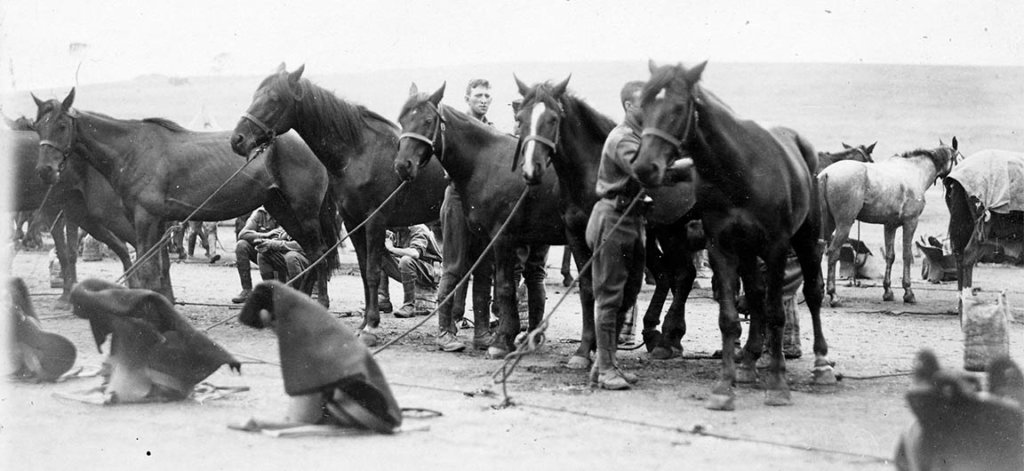A Rare Breed

Story by Steve Meacham. This story was originally published in the September 2019 issue of Reveille. It has been adapted for publication here.
A special correspondent writing for the Sydney Morning Herald on 18 May 1918 described heroic feats he’d witnessed in Egypt and Palestine as the Australian Light Horsemen led the battle north against the Turkish and German forces defending the Ottoman Empire.
“During the past two years the Waler has made war under the most extreme, and diverse conditions,” he wrote. “He has frequently died of thirst and heat in the desert. He has perished in the mud and bitter cold on the Maritime Plain. He has been ridden to a standstill in pursuit of the Turks along good roads, and he has climbed like a goat for days and nights in the steep, stony hills on the way, first to Jerusalem and then to Jericho.”
Most of the 136,000 Australian horses sent overseas during World War I – and the reporter conveniently forgot many of them were mares – were “Walers”: a mixed breed of stock horse prized for its hardiness and ability to survive extreme climates with little food or water.
Originally known as “New South Walers ”, they were much loved by bushrangers, cattlemen and inland explorers. So it is hardly surprising the military identified the Waler as perfect for cavalry duties, smaller and more nimble than the classic English Hunter.
Waler breeder and Light Horse historian Barry Rodgers OAM notes Walers being sent overseas as early as the 1830s for use by the British Army in India. Walers also fought in the Boer Wars before Australia even became a nation. Harry “Breaker” Morant – drover and poet who earned his nickname from his ability to “break” horses – rode many a Waler before the events that led to his controversial execution in 1902.

World War II
Again in World War II, Walers were sent overseas, serving in New Caledonia, India and Burma. They were also used on Australian soil by the North-West Mobile Force (NORFORCE) to patrol northern Australia before the internet age.
“Walers were much better at coping with the landscape than motorised vehicles,” Rodgers says. “They could move stealthily through difficult terrain that was home to crocodiles, snakes and spiders. But with the advent of satellite communications and other forms of surveillance, the Waler became obsolete.”
Famously, the Australian Light Horsemen fought at Gallipoli without their Walers – left behind in Egypt because the terrain was too uncompromising. But the Walers came into their own in the Middle East.
“It takes the new remount at least six months to get accustomed to the strange climate,” wrote the Herald’s reporter. “Horses were never better loved than these. Most of them are pets, with a well-gratified fancy for sugar and chocolate and bread. On a bad ride, men are often seen to pour water from their bottles into their mess tins and share the last pint with their Walers.”
The Most Famous Waler
The most famous Waler was “Bill the Bastard’’, a 16-hand gelding initially considered unrideable – renowned for bucking new Light Horse recruits out of the saddle. Banjo Paterson, poet and war correspondent, grew fond of the stubborn animal during the Middle East campaign, noting in his diary: “You can’t lead Bill the Bastard to anything and you certainly can’t make him drink.”
Yet, during the August 1916 Battle of Romani (near the Suez Canal), Bill and rider Major Michael Shanahan rescued four Tasmanians from certain death. Bill carried three men on his back, with two more hanging off each stirrup, through soft sand at an awkward gallop. This extraordinary action was recently immortalised by New South Wales sculptor Carl Valerius. The life-sized bronze statue now resides in the small town of Murrumburrah-Harden, the birthplace of the 1st Australian Horse infantry regiment.
After Armistice Day, 11 November 1918, the Light Horsemen became aware that their trusty steeds would not be returning to Australia. Just one Waler, Sandy (once ridden by Gallipoli commander Major General Sir William Bridges), is known to have made it back to Australian soil. Some 11,000 Australian horses were sold to the British Army for service in Egypt and India. Many more were shot.
“Trooper Bluegum” wrote a poem that summed up the dilemma many Light Horsemen felt at leaving their Walers behind:
I don’t think I could stand the thought of my old fancy hack
Just crawling round old Cairo with a ’Gyppo on his back.
Perhaps some English tourist out in Palestine may find
My broken-hearted Waler with a wooden plough behind.
No: I think I’d better shoot him and tell a little lie:
“He floundered in a wombat hole and then lay down to die.”
May be I’ll get court-martialled; but I’m damned if I’m inclined
To go back to Australia and leave my horse behind.






